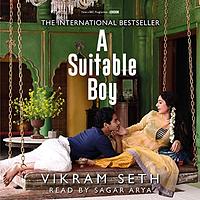Take a photo of a barcode or cover
Not too many surprises, but that's not the kind of book this is. A wonderful slice of life epic.
On the night of May 23, 2019, I was desperately looking for a coping mechanism to recover from the shock that was the election result earlier that day. A worn-out copy of one of the biggest of literary tomes ever written, lying around in Cris’s collection, seemed to be a good diversion for the mind for the weeks ahead.
Yet, after a few pages, I did almost put down the book, being put off by the long drawn out descriptions of a wedding get-together. Around 23 days later, I would thank myself for not succumbing to that urge. Sandwiched between two weddings, is an expansive study of the social situation in the country immediately after it attained independence.
Strangely, it also gave me a better perspective of the communal madness that we are now seeing all around. Several of the exchanges between the characters show how the hatred between communities has always been simmering beneath, worsened by the wounds of partition. If it has not bubbled up to the surface in the initial years of independence, at least until the 1970s or 80s, much credit for it has to go to the kind of leaders, like Jawaharlal Nehru, who were at the helm in that period. On the other hand, we now have leaders who are digging up old wounds, pouring oil on the slowly burning fires.
Nehru and the secular spirit he stood for occupies as much space as the ‘suitable boys’ in the book. We get to read extensively about the antagonism among the hindutvavadis in the Congress party against Nehru. The future sanghis and the forefathers of the present ones, were as communal as the ones we see around now.
At the core of the story is Rupa Mehra’s search for a ‘suitable boy’ for her daughter Lata, a 19-year old college student, who to her mother’s chagrin, has a mind of her own. Popping up all through the novel is the irritating conservatism of Rupa Mehta, who wants to read every letter that her daughter gets or sends, and wants to gather details of every second of the day that her daughter spends outside. Not to forget her obvious hatred of the Muslims.
But the Mehra family only makes part of the book. Three other families – Kapoors, Khans and Chatterjis – and their interactions with each other makes for some riveting scenes and interesting social studies. Like, the chatterji children who recite couplets for every situation, including the ones they are not supposed to make couplets of. Then there is the character of Mann Kapoor, his self-destructive love towards a Muslim courtesan and his deep friendship with the Nawab’s sons, and the senior Kapoor, the revenue minister, who is trying to bring the Zamindari act and land reforms in the state, with the feudal lords and nawabs playing myriad tricks to bypass it.
Vikram Seth has drawn inspiration from his own father to create the character of Haresh, who rises up the ladder in a Czech shoe company. His unpolished exchanges with Lata’s polished, elite brother, stand out. The elaborate descriptions of the business of shoe making, also becomes a study of caste divisions within the sector.
Seth is a master in staging the larger-than-life events, from festivals like Pul Mela (modelled on Kumbh mela), elections or even riots. The descriptions of the day on which the Muharram procession and Ram Lila procession coincides, the tension building up and the inevitable riot, all read like a contemporary long form newspaper report from the Hindi heartland. Only that, the events in the book are happening in 1952. So is the spread of fake news of a death, through pamphlets and posters, the night before the elections.
One could always fault Vikram Seth for not experimenting much with style, which harks back to the century before the previous one. But many modernist or post-modernist works might struggle to capture the depth that this one manages to, with its limited experimentation. In this book which stretches to close to 1350 pages, he does write self-deprecatingly about large books through the character of Amit, the brooding writer, who shares a little secret about how he reads those big books – he tears up the big book into small ones to carry around in his pocket and read, whenever possible. Kindle was still several decades away for Amit.
Yet, after a few pages, I did almost put down the book, being put off by the long drawn out descriptions of a wedding get-together. Around 23 days later, I would thank myself for not succumbing to that urge. Sandwiched between two weddings, is an expansive study of the social situation in the country immediately after it attained independence.
Strangely, it also gave me a better perspective of the communal madness that we are now seeing all around. Several of the exchanges between the characters show how the hatred between communities has always been simmering beneath, worsened by the wounds of partition. If it has not bubbled up to the surface in the initial years of independence, at least until the 1970s or 80s, much credit for it has to go to the kind of leaders, like Jawaharlal Nehru, who were at the helm in that period. On the other hand, we now have leaders who are digging up old wounds, pouring oil on the slowly burning fires.
Nehru and the secular spirit he stood for occupies as much space as the ‘suitable boys’ in the book. We get to read extensively about the antagonism among the hindutvavadis in the Congress party against Nehru. The future sanghis and the forefathers of the present ones, were as communal as the ones we see around now.
At the core of the story is Rupa Mehra’s search for a ‘suitable boy’ for her daughter Lata, a 19-year old college student, who to her mother’s chagrin, has a mind of her own. Popping up all through the novel is the irritating conservatism of Rupa Mehta, who wants to read every letter that her daughter gets or sends, and wants to gather details of every second of the day that her daughter spends outside. Not to forget her obvious hatred of the Muslims.
But the Mehra family only makes part of the book. Three other families – Kapoors, Khans and Chatterjis – and their interactions with each other makes for some riveting scenes and interesting social studies. Like, the chatterji children who recite couplets for every situation, including the ones they are not supposed to make couplets of. Then there is the character of Mann Kapoor, his self-destructive love towards a Muslim courtesan and his deep friendship with the Nawab’s sons, and the senior Kapoor, the revenue minister, who is trying to bring the Zamindari act and land reforms in the state, with the feudal lords and nawabs playing myriad tricks to bypass it.
Vikram Seth has drawn inspiration from his own father to create the character of Haresh, who rises up the ladder in a Czech shoe company. His unpolished exchanges with Lata’s polished, elite brother, stand out. The elaborate descriptions of the business of shoe making, also becomes a study of caste divisions within the sector.
Seth is a master in staging the larger-than-life events, from festivals like Pul Mela (modelled on Kumbh mela), elections or even riots. The descriptions of the day on which the Muharram procession and Ram Lila procession coincides, the tension building up and the inevitable riot, all read like a contemporary long form newspaper report from the Hindi heartland. Only that, the events in the book are happening in 1952. So is the spread of fake news of a death, through pamphlets and posters, the night before the elections.
One could always fault Vikram Seth for not experimenting much with style, which harks back to the century before the previous one. But many modernist or post-modernist works might struggle to capture the depth that this one manages to, with its limited experimentation. In this book which stretches to close to 1350 pages, he does write self-deprecatingly about large books through the character of Amit, the brooding writer, who shares a little secret about how he reads those big books – he tears up the big book into small ones to carry around in his pocket and read, whenever possible. Kindle was still several decades away for Amit.
I don't think I'll be able to finish reading this book. Ever.
challenging
emotional
funny
hopeful
informative
inspiring
reflective
sad
medium-paced
Plot or Character Driven:
A mix
Strong character development:
Yes
Loveable characters:
Yes
Diverse cast of characters:
Yes
challenging
emotional
funny
sad
tense
medium-paced
Plot or Character Driven:
A mix
Strong character development:
Yes
Loveable characters:
Complicated
Diverse cast of characters:
No
Flaws of characters a main focus:
Yes
challenging
emotional
inspiring
reflective
sad
slow-paced
Plot or Character Driven:
Character
Strong character development:
Yes
Loveable characters:
Yes
Diverse cast of characters:
Yes
Flaws of characters a main focus:
Yes
Loved it! Thanks god it is the longest book in English, because I really enjoyed it. Full of memorable characters drawn with humanity and humor. Such a huge book, and so much ground covered.
Accidentally listened to the BBC radio adaptation of the book, which was fairly enjoyable but difficult to follow at times.
Format is difficult to listen to. Background sounds are loud. Voices are low. The story is disjointed. And it is boring.
reflective
slow-paced
Plot or Character Driven:
A mix
Strong character development:
Yes
Loveable characters:
Complicated
Diverse cast of characters:
Yes
Flaws of characters a main focus:
No
Took me almost a month to tackle this one - I will admit to skimming probably 300 of the 1500 pages that delved into the political subplot - but -overall enjoyed it.




